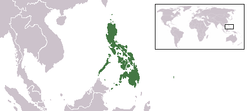
Back جمهورية بياك نا باتو Arabic República de Biac-na-Bató AST Republik von Biak-na-Bato German República de Biac-na-Bató Spanish République de Biak-na-Bato French Republik Biak-na Bato ID República de Biak-na-Bato Portuguese Республика Биак-на-Бато Russian สาธารณรัฐเบียก-นา-บาโต Thai Republika ng Biak-na-Bato Tagalog
Republic of the Philippines Republika ng Pilipinas (Tagalog) | |||||||||||||
|---|---|---|---|---|---|---|---|---|---|---|---|---|---|
| 1897 | |||||||||||||
 Territory claimed by the Republic of Biak-na-Bato in Asia | |||||||||||||
| Status | Unrecognized state | ||||||||||||
| Capital | San Miguel | ||||||||||||
| Official languages | Tagalog[1] | ||||||||||||
| Religion | Roman Catholicism, Islam | ||||||||||||
| Government | Revolutionary republic | ||||||||||||
| President | |||||||||||||
• 1897 | Emilio Aguinaldo | ||||||||||||
| Vice President | |||||||||||||
• 1897 | Mariano Trías | ||||||||||||
| Historical era | Philippine Revolution | ||||||||||||
| November 1, 1897 | |||||||||||||
| December 14, 1897[2] | |||||||||||||
| Currency | Peso | ||||||||||||
| |||||||||||||
| History of the Philippines |
|---|
 |
| Timeline |
|
|
The Republic of Biak-na-Bato (Tagalog: Republika ng Biak-na-Bato) was the second revolutionary republican government led by Emilio Aguinaldo during the Philippine Revolution that referred to itself as the Republic of the Philippines (Tagalog: Republika ng Pilipinas) and was seated in what is now Biak-na-Bato National Park. The current designation was adopted by historians to avoid confusion with the name of the current Philippine government, which also refers to itself as the Republic of the Philippines, and with other past Philippine governments using the same designation.
The Biak-na-Bato republic lasted just over a month. It was disestablished by a peace treaty signed by Aguinaldo and the Spanish Governor-General, Fernando Primo de Rivera, which included provisions for the exile of Aguinaldo and key associates to Hong Kong.
- ^ Cite error: The named reference
BnBconstitutionwas invoked but never defined (see the help page). - ^ Don Emilio Aguinaldo y Famy (September 23, 1899), "Chapter II. The Treaty of Biak-na-bató", True Version of the Philippine Revolution, Authorama: Public Domain Books, retrieved September 23, 2008

